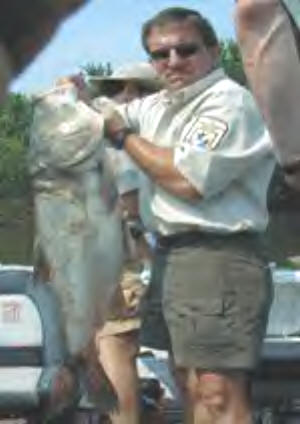Battle On to Bar Asian Carp, Another Threat to Great Lakes Fishing
|
||||||||||
| Printer Friendly Story View |

Four foot long, up to 120 pounds, Asian carp, like this monster in a U.S. Fish and Wildlife Service photo, are another major threat to fishing on the Great Lakes.
They thrash around in the Illinois River, gateway from the Mississippi River to the Great Lakes.
Thousands of them, weighing up to 120 pounds, an exotic species escaped from Southern fish farms.
They are skittish; thesound of a motor sometimes causes them to jump into boats. Several staff members of the U.S. Fish and Wildlife Service have been injured by their tail flapping.
"They" are Asian carp, huge, fast-breeding "river rabbits" that suck up plankton needed by smaller fish to survive.
The carp have reached points on the Illinois River only a few miles from Lake Michigan. The fish have the capability of moving up to 120 miles in a month. If they succeed in invading, Lake Huron and the other lakes would soon see their effects.
Asian carp are another threat to Great Lakes fishing, along with Cormorants, the nasty fish-devouring birds we told you about a few weeks ago in this column.
Together, unless controlled, the black deep-diving birds and prolific, ravenous carp certainly would soon snap the food chain and end our traditional lakes fishing paradise.
Cormorants already have depleted the perch, smelt and alewives and driven charter boats out of Lake Huron. (See "Rapacious Cormorants Decimating Perch, Smelt in Lake Huron," MyBayCity.com, Nov. 25, 2004, Outdoors section.)
In the Chicago Sanitary and Ship Canal near Chicago, a grim struggle is going on to keep the carp out of the Great Lakes. An electric weir in the canal has recently been replaced by a $6.7 million federal/state-funded dispersal barrier at Romeoville, Illinois.
"Without an effective barrier on the canal, three species of Asian carp, black,bighead and silver carp, among other invaders, would have a clear path to the Great Lakes," states U.S. section chairman Bernard J. Hansen of the Great Lakes Fishery Commission, based in Ann Arbor, Michgian.
Full funding to construct, operate and maintain the barrier is pending in Congress, along with a bill entitled the "National Aquatic Invasive Species Act" to control ship ballast discharges and importation of live food-fish.
"The urgency of this project cannot be overstated -- these carp must not be allowed to enter our Great Lakes," says Gerry A. Barnhart, director of the New York Division of Fish, Wildlife and Marine Resources.
"These fish are voracious eaters, they reproduce and spread quickly, out-compete native fish and are well-suited to the climate of the Great Lakes. Based on the havoc these carp have wreaked on the Mississippi River, we have every reason to believe they would devastate the Great Lakes ecosystem as well, should they enter the lakes."
How did such a threat arise? The black and silver carp were imported by catfish farmers in the 1970s to control algae and other vegetation in their ponds. Flooding in the early 1990s released some of the carp into waterways leading to the Mississippi.
The carp decimated the fishing stocks and drove fishers out of some favorite fishing holes on the Mississippi and Illinois rivers. They are so dominant that few years ago 97 percent of a fish kill south of St. Louis was comprised of Asian carp.
(Watch for columns in coming weeks about other threats to the Great Lakes from a series of aquatic nuisance species including snakehead, zebra mussels, round goby, sea lamprey, Eurasian ruffe, spiny and fishhook waterfleas and invasive aquatic plants like purple loosestrife and hydrilla, being addressed by experts from Michigan State University.)###
| Printer Friendly Story View |
|
|

Dave Rogers |
|
|
|
Printer-Friendly Story View
0200 Nd: 04-15-2024 d 4 cpr 0
12/31/2020 P3v3-0200-Ad.cfm
SPONSORED LINKS
12/31/2020 drop ads P3v3-0200-Ad.cfm


